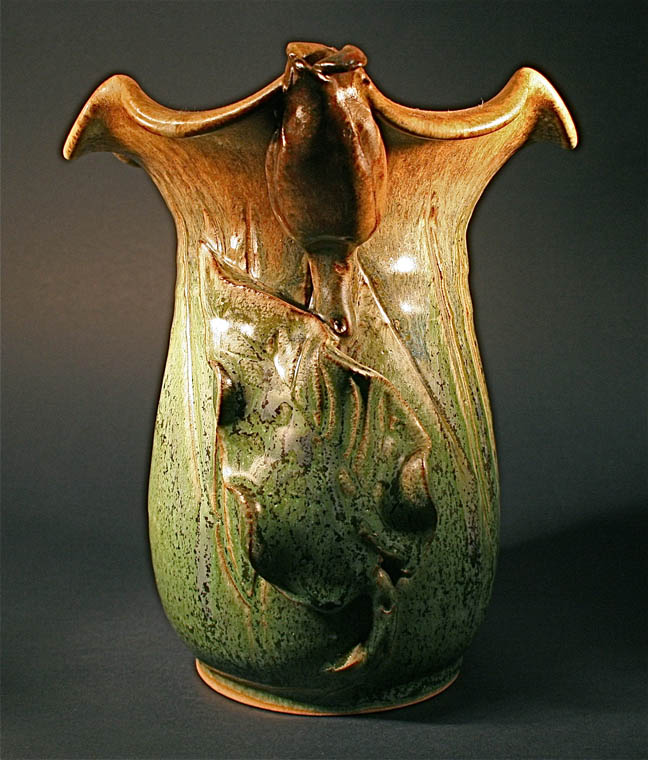

Title: Antique Arts and crafts Handmade Stone Pottery Flower Light Vessel
Shipping: $25.00
Artist: N/A
Period: Contemporary
History: N/A
Origin: N/A
Condition: Excellent
Item Date: 1880 to 1920
Item ID: 2421
Rare decorative Mood Pottery Light Cover – Light is elegantly projected and focused onto the Ceiling. For sale, I have a splendid organic Art Nouveau and Arts and Crafts-style ceramic vase. This is a classic flower urn-shaped vessel, beautifully designed with a vertically carved flower paired with a stylized Arts and Crafts leaf, separated by a delicate light stem. The lower half of the vase showcases a pleasing matte tan and light green glaze, accented with subtle mottling. The top half is a rich brown with an outstanding finish! Additionally, the vase includes a designated area for threading a cord from both above and below the light, making it functional as well as decorative. Art Nouveau and the Arts and Crafts movements emerged in the late 19th and early 20th centuries as reactions to industrialization and mass production. These styles emphasized craftsmanship, organic forms, and the harmony between function and beauty.
The Art Nouveau style (circa 1890–1910) drew inspiration from nature, with flowing, asymmetrical lines and motifs like flowers, leaves, and vines. Ceramics in this style often featured intricate carvings and delicate glazes, embodying the era's fascination with fluidity and elegance. In contrast, the Arts and Crafts movement (circa 1880–1920) valued simplicity and traditional techniques. It focused on handcrafted items with natural materials and earthy tones. Ceramics from this period showcased subtle, matte glazes, understated ornamentation, and a preference for practical forms with aesthetic appeal. A vase blending these two styles, like the one described, would reflect the organic designs of Art Nouveau with the functional simplicity and earthy tones of Arts and Crafts. Such pieces were often produced by skilled artisans who embraced the philosophy of elevating everyday objects into works of art. These vases remain celebrated for their timeless elegance and the artisanal care that went into their creation, making them prized by collectors and design enthusiasts alike.
Link: http://en.wikipedia.org/wiki/Pottery
Pottery is the ceramic ware made from clay by potters. Major types of pottery include earthenware, stoneware, and porcelain. The places where such wares are made are called potteries. Pottery is one of the oldest human technologies, and remains a major industry today. Pottery is made by forming a clay body into objects of a required shape and heating them to high temperatures in a kiln to induce reactions that lead to permanent changes, including increasing their strength and hardening and setting their shape. There are wide regional variations in the properties of clays used by potters and this often helps to produce wares that are unique in character to a locality. It is common for clays and other minerals to be mixed to produce clay bodies suited to specific purposes. Firing produces irreversible changes in the body. It is only after firing that the article can be called pottery. In lower-fired pottery the changes include sintering, the fusing together of coarser particles in the body at their points of contact with each other. The atmosphere within a kiln during firing can affect the appearance of the finished wares. An oxidising atmosphere, produced by allowing air to enter the kiln, can cause the oxidation of clays and glazes. A reducing atmosphere, produced by limiting the flow of air into the kiln, can strip oxygen from the surface of clays and glazes. This can affect the appearance of the wares being fired and, for example, some glazes containing iron fire brown in an oxidising atmosphere, but green in a reducing atmosphere. The atmosphere within a kiln can be adjusted to produce complex effects in glaze. Kilns may be heated by burning wood, coal and gas, or by electricity. When used as fuels, coal and wood can introduce smoke, soot and ash into the kiln which can affect the appearance of unprotected wares.